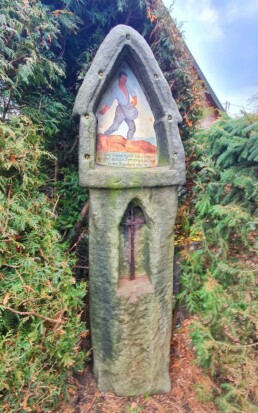BOARD 13 - THE FLAGELLATION COLUM
The flagellation column of Ruppendorf is set on the border of the “Am Mühlgraben 47” property. It has probably been made from a monolithic sandstone column in the middle of the 14th/15th Century and been put up by a member of the Theler family. This, however, has never been proven. It is not part of the seven flagellation columns which Conrad Theler had set up after a cruel and bloody deed. In 1529 the Hussites, in 1632 the imperial soldiers and in 1639 the Swedish must have passed by the column since the today’s street “Am Mühlgraben” used to be a military road back then.
In 1932 the flagellation column was found behind a pile of logs by Hubert Ermisch leaning toward a corner of the house. It had been used for a long time as a gate column at the entrance to the courtyard. Corresponding recesses for a wooden bar are still visible today. The column was set into the ground almost 75 centimeters.
The hundredweight colossus was dug up at the time and carried to its present location. Because the column had already contained a recess for a crucifix, a handmade crucifix was placed within. The upper picture recess was decorated with a picture to remember the difficult years 1931/32 (as a consequence of the worldwide economic crisis). The picture “Der Säemann”, a picture of a sowing farmer, was painted by the Dresden painter Hede von Eckardstein and described with the words “Der aber dem Samen reichet dem Säemann der wird auch das Brot reichen zur Speise” which translates to “who gives the seed to the sowing farmer is also giving the bread for the meal”. These lines have been fit well into the odd shape of the picture recess.
The original character of the column has been recreated as best as possible. Today it is protected as a historic monument.

